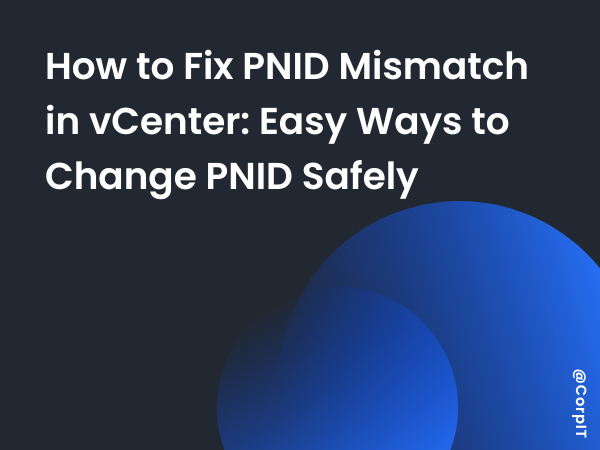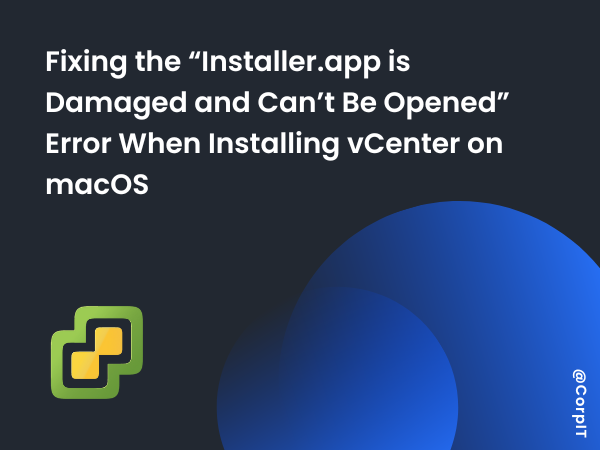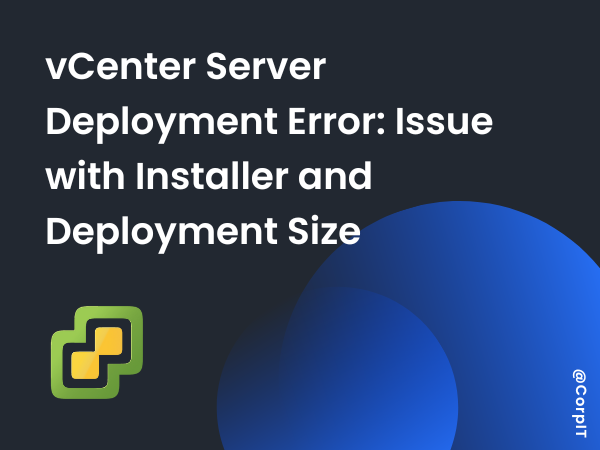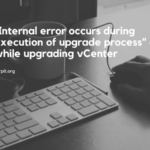When upgrading vCenter Server, one of the most common issues administrators encounter is the PNID mismatch error. This error occurs when the Platform Services Controller Node ID (PNID) doesn’t match the vCenter hostname, preventing the upgrade from continuing.
In this guide, you’ll learn what PNID is, why mismatches happen, and step-by-step instructions to change PNID in vCenter using both the VAMI (vSphere Appliance Management Interface) and CLI (Command-Line Interface).
Table of Contents
What Is PNID in vCenter?
PNID stands for Platform Services Controller (PSC) Node ID. It’s a unique identifier assigned during the installation of the vCenter Server or Platform Services Controller.
PNID helps vCenter maintain secure communication between nodes and ensures consistency across your vSphere environment. Typically, PNID takes the form of a Fully Qualified Domain Name (FQDN) or IP address.
You can view the current PNID using the command below:
/usr/lib/vmware-vmafd/bin/vmafd-cli get-pnid --server-name localhostIf this PNID doesn’t match your hostname, you’ll likely encounter an error during a vCenter upgrade.
Why a PNID Mismatch Occurs
A PNID mismatch usually happens when the vCenter’s hostname or FQDN has been changed after installation but the PNID hasn’t been updated to reflect it. During upgrades, vCenter compares the two values, and if they differ, the upgrade fails.
To resolve this, you’ll need to update the PNID to match the hostname. You can do this through either the VAMI interface or the Command Line Interface (CLI).
Methods to Change PNID in vCenter
There are two main methods to change the PNID in vCenter:
- Using VAMI (vSphere Appliance Management Interface) – Best for simplicity and speed.
- Using CLI (Command-Line Interface) – Ideal for administrators comfortable with shell commands.
Both approaches work, but your choice will depend on preference and environment requirements.
How to Change PNID in vCenter Using VAMI
The VAMI method is user-friendly and doesn’t require command-line expertise. Follow these steps carefully:
- Open a web browser and go to:
https://<vCenter_Server_Appliance_IP_or_FQDN>:5480- Log in using root credentials.
- Click on the Networking tab in the left sidebar.
- Select the Address tab and choose the appropriate network interface.
- Click Edit and update the Platform Services Controller Node ID field with your new PNID.
- Click Save Settings to apply the changes.
- Restart vCenter services:
- Go to the Summary tab.
- Scroll down to Services and click Restart.
After the restart, the new PNID will appear in the vSphere Web Client under vCenter Server Systems.
Tip: Always test PNID changes in a staging environment before applying them in production.
How to Change PNID in vCenter Using CLI
If you prefer using the command line or are troubleshooting from SSH, you can easily change PNID in vCenter using CLI.
Steps:
- Log in to the vCenter Server Appliance shell as
root. - Update the PNID using this command:
/usr/lib/vmware-vmafd/bin/vmafd-cli set-pnid --server-name localhost --pnid <NEW-PNID-NAME>- Replace
<NEW-PNID-NAME>with your desired FQDN or hostname. - Restart all vCenter services to apply the change:
service-control --stop --all
service-control --start --allOnce the services restart, verify the update from the vSphere Web Client. The new PNID should now be active.
Post-PNID Change Tasks
After changing the PNID, you’ll need to perform a few additional steps to maintain environment stability:
- Rejoin the vCenter Server to Active Directory (AD).
- Regenerate all custom SSL certificates.
- Re-register integrated VMware products (like vRealize or NSX).
- Reconfigure vSphere High Availability (VCHA) if it’s enabled.
Completing these steps ensures that all components recognize the updated PNID.
Best Practices Before Changing PNID
- Take a full backup or snapshot of your vCenter Server Appliance.
- Document your configuration, including network settings and service registrations.
- Test the process in a non-production environment first.
- Always verify connectivity post-change to avoid service interruptions.
FAQs About Changing PNID in vCenter
PNID stands for Platform Services Controller Node ID, a unique identifier for your vCenter Server or PSC instance.
During an upgrade, vCenter compares your PNID with your hostname. If they don’t match, the upgrade fails to ensure configuration consistency.
No, restarting vCenter services is required after changing the PNID, which temporarily disrupts availability.
Both methods work. The VAMI method is simpler, while the CLI method provides more control for advanced users.
Rejoin Active Directory, regenerate SSL certificates, re-register integrated products, and reconfigure HA if applicable.
Conclusion
Changing the PNID in vCenter is an important but sensitive task. It ensures consistency between your hostname and vCenter identity, which is crucial for upgrades and integrations. Whether you use VAMI or CLI, always back up your environment and verify the change before going live.
With careful preparation and testing, you can fix PNID mismatches confidently and keep your vCenter environment running smoothly.









